10 Most Famous Renaissance Paintings
The about famous Renaissance paintings span a period of some 300 years and marked a catamenia of revolution in art that has non been equaled to this twenty-four hour period.
The Renaissance spans over three centuries from the 14th to the 17th century AD and marked a boom in classical based artworks that have stood the exam of time.
About notable were information technology's artists and their return to classical thinking and the philosophies of the ancient Greeks and Romans.
Today such names as Da Vinci, Michelangelo, Botticelli and Raphael are all considered geniuses and their contribution to fine art, the humanities, scientific discipline and philosophy is unequaled.
Renaissance paintings saw a quantum leap forrard in terms of materials and techniques, with the linear perspective and highly authentic anatomical representation of the man grade featuring heavily.
Many groovy works were funded by either wealthy merchants or deputed by the Catholic church.
The following listing of the nearly famous renaissance paintings is not exhaustive just it does detail the about notable works.
Famous Renaissance Paintings
1. Mona Lisa
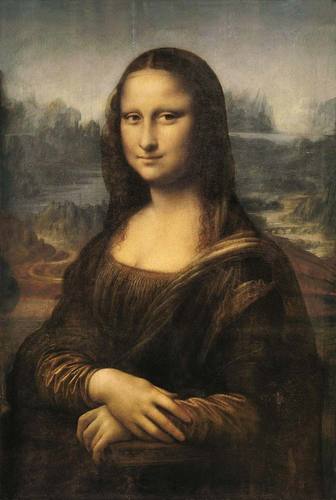
The Mona Lisa could be considered the single well-nigh famous painting in the globe and also the virtually famous smile to boot!
To his name Da Vinci has relatively few completed canvases when compared to other prolific proponents of the time.
However, all of his works are a considered true main pieces which is an honor that is bestowed on very few people.
The Mona Lisa is a half height portrait and is believed to be of Lisa Gherardini who was the married woman of a rich Florentine merchant by the proper noun of Francesco del Giocondo.
The Mona Lisa is now owned by the French public and is on brandish at the Louvre, it is held in trust for the public and tin never be sold.
It was in one case stolen by an Italian employee and taken back to Italian republic who claimed that is where it belongs. He was eventually caught and the piece was returned to the Louvre.
There are long ques everyday only to take hold of a glimpse of her famous smile.
She is easily the most famous painting of the renaissance period if not of all time.
2. The Last Supper
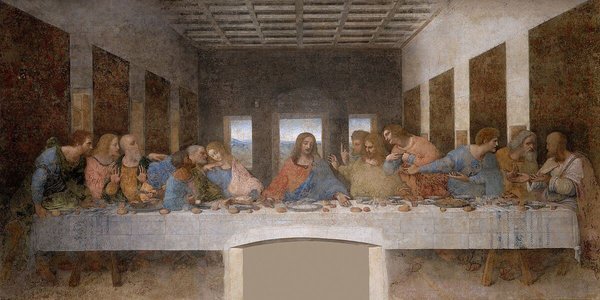
Like a lot of famous renaissance works of art The Last Supper is a religious scene and depicts the last supper of Jesus and his twelve apostles and was painted past Leonardo Da Vinci.
Information technology is a non the typical fresco that is commonly painted on walls instead Leonardo decided to use his preferred oil paints instead.
Leonardo is said to favor oil as it is tiresome drying and allowed him to brand changes and take a slower more considered approach to the piece of work.
Too Read: Leonardo da Vinci Paintings
Leonardo realized that if is he was to use oil paints and so the natural moisture that permeates through most stone wall buildings would have to be sealed other wise it would ruin his piece of work.
To counter this he applied a double layer of gesso, mastic and pitch.
Throughout it's long history he painting had to be restored several times.
The upshot of both environmental and intentional damage, very little of the original top layer of oil painting is left.
3. The Creation of Adam
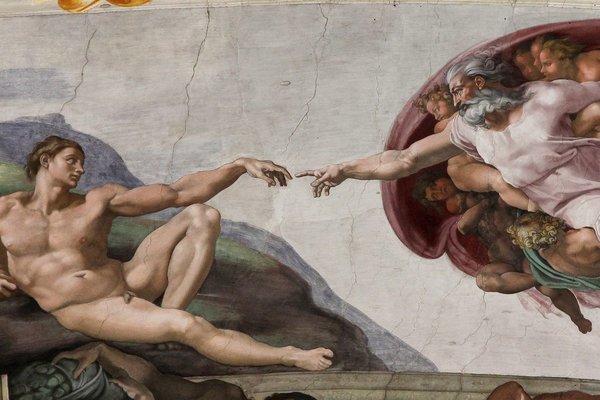
The Creation of Adam was painted by Michelangelo in roughly 1508 to 1512.
Information technology course the central epitome in the ceiling of the Sistine Chapels' ceiling.
The image depicts God giving life to Adam from the Book of Genesis and has become 1 of the most iconic and reproduced images ever produced.
The full area is roughly over 500 foursquare meters and information technology took Michelangelo over four years to finish what is 1 of the virtually complex and largest fresco paintings e'er attempted.
In all there are some 300 figures, but the Cosmos of Adam focuses on God on the right giving life to Adam who represents man.
Adam is lying on the border of the earth in a rather relaxed fashion and God is carried by his angels reaching across to Adam to give the gift of life through his touch.
To truly capeesh the grandeur of one of the renaissances finest fine art works you must walk nether the ceiling of the Sistine chapel and gaze upwards.
four. Primavera
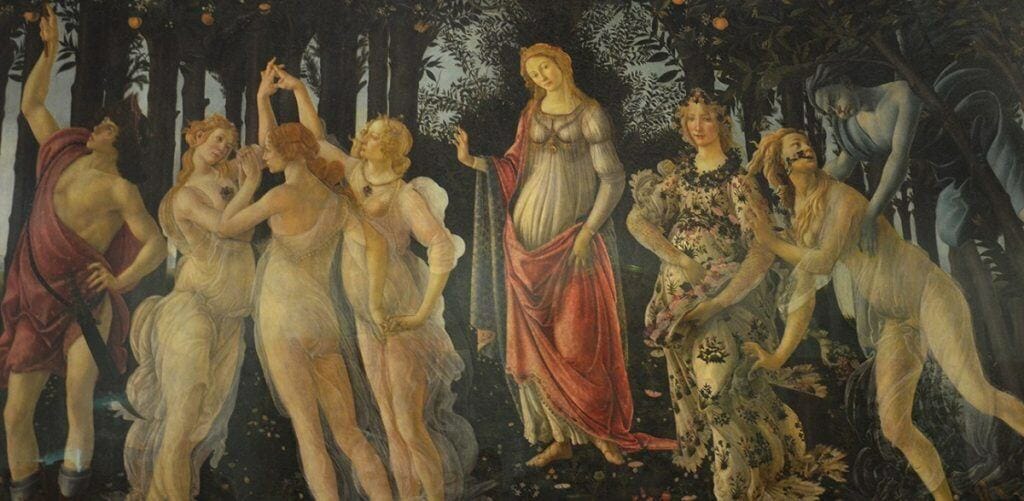
Sandro Botticelli is believed to take painted Primavera in 1482 the proper noun in English language means Spring and the painting is sometimes referred to as 'Allegory of Spring'.
The actual scene and what it represents is the cause of much debate among artistic scholars and commentators with some saying information technology portrays a mythical allegory and others the changing of the seasons.
Information technology is i of the finest renaissance art examples and is not but of annotation due to information technology'due south meaning but also in Botticelli'south use of color which was rather striking for the age that information technology was painted in.
five. The School of Athens
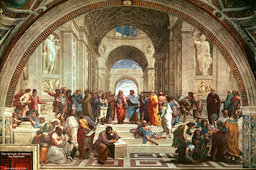
The School of Athens is a fresco that was painted be Raphael betwixt 1509 and 1511 in the Churchly Palace in the Vatican.
The painting features almost always of import Greek philosopher.
It is painted in the Stanza della Segnatura which is on the second floor in the Due north wing of the Vatican Palace.
Information technology is one of four large fresco's painted in that room with each of the four representing the branches of homo noesis which are Justice, Philosophy, Poesy and the School of Athens.
The use of perspective features heavily in the composition and the heart is drawn towards the two fundamental figures Plato on the left and Aristotle on the correct.
On the left are philosophers that represent Plato's philosophies and on the right philosophers that represent Aristotle'southward philosophies with a sum total of 50 figures in the painting.
6. The Nativity of Venus
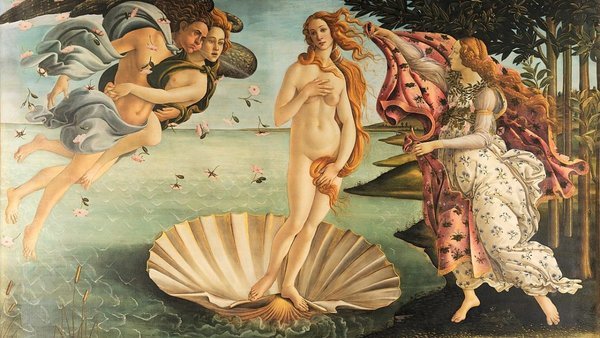
Ane of Botticelli's finest renaissance works of art The Nascence of Venus features the Roman goddess Venus as she arrives on shore having been born fully grown at sea, she is delivered on a giant vanquish.
Sandro Botticelli was responsible for that other famous renaissance painting that depicts a mythological paradigm the Primavera.
Both bully works of fine art were commissioned by the powerful banking dynasty the Medici who were extremely stiff patrons of fine art in Florence.
Previous to this fourth dimension the bulk of works would accept been painted on woods panels but the Birth of Venus is actually tempura on sheet.
Canvas had a distinct reward over forest as in humid climates woods had a tendency to warp whereas canvas did not.
7. Sistine Madonna
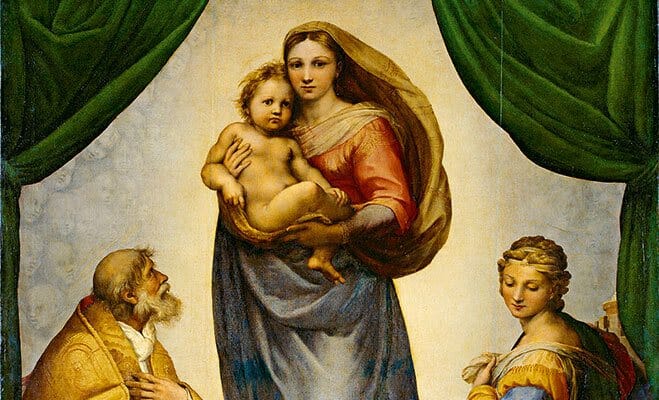
The Sistine Madonna was one of Raphael's terminal bang-up works of renaissance fine art, he died but a few curt years later.
The painting depicts the Virgin Mary property the baby Jesus flanking her in the image are Saint Sixtus and Saint Barbara, below her in the foreground are cherubs that gaze up towards Mary.
The painting was painted for the Benedictine Monks in the San Sisto Monastery Piacenza which was hung in pride of place almost the alter.
Information technology later found information technology'due south way to Germany in 1754 to King Agustus Iii of Saxony, upon it's arrival in Germany it caused considerable argue questioning the lines between art and religion.
The painting would after move to Moscow after Earth State of war II and and then finally returning to Germany in 1955.
Information technology is considered one of the nearly famous Renaissance paintings of the Virgin Mary and was a master class from Raphael in terms of light and shadow.
viii. The Concluding Judgement

The Terminal Sentence is massive fresco painted by Michelangelo that adorns the whole alter wall of the Sistine Chapel in the The holy see.
It took Michelangelo over four years between 1536 and 1541 to complete due to not only it's size simply as well the complexity and the number of figures.
He started working on it 25 years afterwards the completion of the Sistine Chapel Ceiling and by that stage was considerably old at 67 by the time it was completed.
Originally all of the males were painted as nudes only they were later on covered upwards past the addition of painted draperies.
Initially the reception was mixed between praise and criticism with the nudes beingness a major talking bespeak as likewise was how muscular a lot of the figures were.
ix. The Buss of Judas
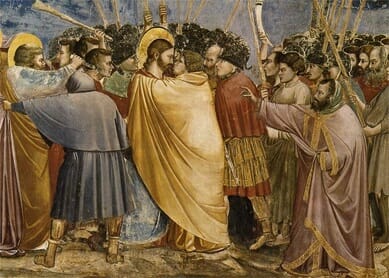
The Kiss of Judas is also known every bit the Betrayal of Christ and depicts the scene of Judas making Christ known to the officers of the Sanhedrin which led to his abort and ultimate execution.
Information technology was painted past Giotto di Bondone and was commissioned past the powerful banking family unit the Scrovengi'south in the Scrovengi Chapel which was congenital by the family on the site of an ancient Roman arena.
The painting is probably most famous for the fact that it marked an end to the familiar medieval fashion of painting and heralded in the new wave of artistic revolution that was the early renaissance.
The series of fresco's that Giotto painted for the rich banking family were considered at the time to be the almost modernistic works of art of whatsoever artist.
10. The Assumption of the Virgin
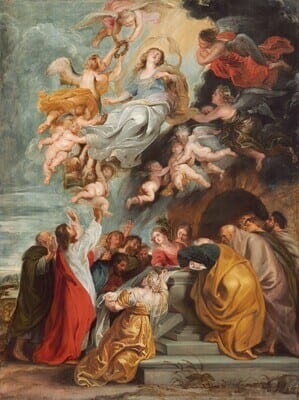
The Assumption of the Virgin also known as the Frari assumption is a painting past Titan that resides at the high altar at the Basilica di Santa Maria Gloriosca dei Frari in Venice.
Information technology was painted by Titan betwixt 1515 and 1518 and is the largest altar piece in Venice.
For Titan it was the beginning fourth dimension he sought to emulate the more than modernistic dynamic scenes that Raphael and Michelangelo were condign known for further s in Florence.
The painting is framed by massive marble columns and gilded edges and forms a rather striking piece when viewed from the other cease of the church.
Italian Renaissance Paintings
The Italian Renaissance painting movement marked a massive movement away from the more Gothic scenes of medieval art that preceded information technology to a return to more than humanistic approach to both fine art and thinking.
Inspired heavily past the neat Greek philosophers and thinkers the renaissance artists cast off the previous focus on symbolism and focused there attention to the individual.
The ascension of the wealthy merchants and banking families such every bit the Medici from Italian cities such as Florence and Venice immune for a marked increment in financial support for up and coming artists to showcase there more modern style.
The reduced power and influence of the church building besides had an affect equally the spread of humanism was allowed to grow, whereas previous churches would have resisted such developments.
That being said the church building were however a massive consumers of Renaissance art with many of the nearly famous Renaissance paintings beingness fresco's that beautify the interior of some of Italy finest chapels and cathedrals.
The bulk of renaissance art examples are to exist found in Italy with many famous oil paintings withal in good condition however a big portion of the fresco's still surviving take been subject to substantial alterations by way of conservation.
Early Renaissance Art (1400 – 1500)
Early Renaissance art was a bridge between the previous Byzantine Gothic style of art and the more modern humanistic approach to both art, compages, thinking and science.
The Florentine painter Giotto was one of the first to suspension free from the in roughly 1300 to 1310 with his fresco'due south of the Scrovegni Chapel.
This period between 1300 and 1400 is considered the proto-renaissance and marked a gradual deviation from archetype symbolic Byzantine art with religious images featuring apartment 2D painting techniques to a more than naturalistic approach.
Giotto led the way for the early renaissance which was led by the likes of Brunelleschi, Donatello and Masaccio with the great banking families of Florence encouraging and funding this new movement.
Both Brunelleschi and Donatello revolutionized the employ of linear perspective and gave life and depth to painting and architectural drawings.
High Renaissance Art
The high renaissance is a roughly thirty year flow were all of the great names were highly active and often competing with each other for diverse commissions.
Well-nigh historians would consider that high renaissance art started in roughly 1495 and ended 1520 and was signaled by the decease of Raphael.
All of the not bad names in fine art, architecture, sculpture, and the sciences peculiarly human anatomy were at the meridian of their creative powers.
Da Vinci, Raphael, Michelangelo and Bramante embraced new techniques, materials and the progression and refinement of linear perspective.
Massive canvasses and fresco's were undertaking on a never before seen scale and to this day are nevertheless considered some of the most famous renaissance paintings ever made.
Source: https://www.artst.org/renaissance-paintings/
0 Response to "10 Most Famous Renaissance Paintings"
Post a Comment